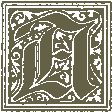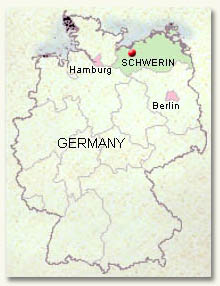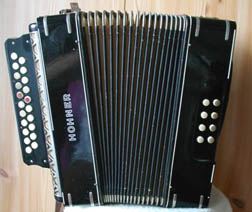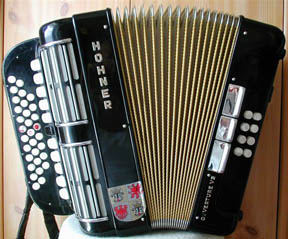|
The “Treckfiedel”
of
Mecklenburg
by
Hannelore Hinz (a.k.a. “Treckfiedel-Hanne”)
Schwerin, Germany, 2008
Translated by Reinhard F. Hahn, Seattle, USA
 s
it goes in a harvest song from Mecklenburg (in the Low Saxon dialect
of Malchin district): s
it goes in a harvest song from Mecklenburg (in the Low Saxon dialect
of Malchin district):
Allens is vergäten,
wat uns dag’s hett quäält,
wenn uns’ Vadding abends
de Treckfiedel* späält. |
All the things that made us sad
Throughout the day are gone
When in the evening our dad
Plays the accordion.* |
 “Treckfiedel-Hanne” (Hannelore
Hinz, the author) with one of her Teckfiedels
“Treckfiedel-Hanne” (Hannelore
Hinz, the author) with one of her Teckfiedels |
*Treckfiedel. What’s behind this word? We are talking about the accordion, the “squeeze box.” Treckfiedel is a commonly
used Low Saxon (“Low German”) word for this instrument that has been
popular for rural entertainment and smaller domestic celebrations.
As recorded on the Isle of Poel in 1889, an earlier word for
it is Monika (from Harmonika ‘accordion’).
Treckfiedel means ‘accordion’, but Fiedel actually means ‘fiddle’,
and trecken means ‘to pull’ or ‘to drag’.
 The accordion has many Low Saxon names, besides Treckfiedel for instance Treckharmonika (“pull harmonica”), Treckbüdel (“pull bag”,
possibly in comparison with the bagpipe), Treckkasten (“pull box”, because
of its shape), Handmonika (“hand (har)monica”), and also Quetschfiedel (“squeeze fiddle”), Quetschkasten (“squeeze box”) and Quetschkommod’ (“squeeze
chest”) because the bellows needs not only be pulled but also squeezed. The accordion has many Low Saxon names, besides Treckfiedel for instance Treckharmonika (“pull harmonica”), Treckbüdel (“pull bag”,
possibly in comparison with the bagpipe), Treckkasten (“pull box”, because
of its shape), Handmonika (“hand (har)monica”), and also Quetschfiedel (“squeeze fiddle”), Quetschkasten (“squeeze box”) and Quetschkommod’ (“squeeze
chest”) because the bellows needs not only be pulled but also squeezed.
Among day laborers it also came to be known as Daglöhnerörgel (“day laborers’ organ”), because it was the musical instrument of the
poor. This information goes back to ethnographer Richard Wossidlo (1859–1939),
to whom ordinary people affectionately referred as Perfesser Voßlo.
 One
of the author’s Treckfiedels, a 90–100-year-old “Viennese” model with a same-tone key and an additional short row of key buttons.
One
of the author’s Treckfiedels, a 90–100-year-old “Viennese” model with a same-tone key and an additional short row of key buttons.
Please
click below to listen to the author playing the Windmöllerdanz (Wind Miller’s Dance) on this
instrument (or click here to download and save it). |
|
These
days, townspeople enjoy playing it too, and I am one of them.
According to the records, the accordion found its place in
Mecklenburg a good sixty years after its invention.
Although this is debatable, it is widely believed that the
first accordion was built by Friedrich Buschmann in Berlin in 1822. He
also gave it the German name Handäoline (“hand aeoline”). Mundäoline (“mouth aeoline”) was his name for
the harmonica (mouth organ) with whose invention in 1821 he has been credited as well.
 Another of
the author’s Treckfiedels,
circa 90 years old without same-tone key.
Another of
the author’s Treckfiedels,
circa 90 years old without same-tone key.
Please
click below to listen to the author playing the Mecklenburg Waltz on this instrument (or click here to download and save it). |
|
The first accordion models had single rows of button keys
and were diatonic. They were not yet of the Viennese type, did not yet
come with button keys that play the same tone upon pulling and squeezing.
As a schoolgirl I used to own one of those one-row squeezeboxes
in C major with the basses Cmaj/Gmaj, Cmin/Gmin and Amaj/Dmaj, Amin/Dmin.
A Mecklenburger doesn’t like it when outsiders refer to his
squeezebox in German as Akkordeon or even Schifferklavier (“skipper’s
piano”). “Dat is ’ne Treckfiedel” (“It’s a Treckfiedel”), he’d say proudly.
 This
is the author’s latest and most often played Treckfiedel.
This
is the author’s latest and most often played Treckfiedel.
Please click below to listen
to a sample the author played on this instrument (or click
here to download and it).
|
|
What do we mean by “diatonic”? Depression of a certain button
key produces a different tone, thus a change tone, while the bellows
is pulled (expanded) or squeezed (contracted).
Here’s an example. When you press the C' button while squeezing
the bellows it is exactly that tone you get. When you pull the bellows
you hear a D'. But when press C'' you get a B' when you pull. This takes
patient practice.
The diatonic method makes learning to play harder, but some
day it starts coming naturally and you produce Treckfiedel music, which
is enjoying popularity once again.
 Hanne (left) with her Treckfiedel and three other Mecklenburger characters in front of the well
of Schwerin’s meat market named “Von Herrn Pasturn sien Kauh” (after a popular Low Saxon folksong)
Hanne (left) with her Treckfiedel and three other Mecklenburger characters in front of the well
of Schwerin’s meat market named “Von Herrn Pasturn sien Kauh” (after a popular Low Saxon folksong) |
Manufacturers kept creating new instruments that were easier
to play.
The Viennese type began to be available as early as in 1829.
In the F minor row on my Viennese-style Treckfiedel the C''
key has the same tone when the bellows are squeezed and pulled.
„Laat de Fiedel un Fläuten gahn!“ (“Let fiddel and flutes
have their way!”) And these instruments came to be joined by the Gaushals (“goose neck,” clarinet), the double bass and the Treckfiedel.
|
Source:
Wossidlo, Richard and Hermann Teuchert: Wossidlo-Teuchert
mecklenburgisches Wörterbuch, mit Unterstützung der Mecklenburgischen
Landesregierung, der Mecklenburgischen Landes-Universitäts-Gesellschaft
und der Deutschen Forschungsgemeinschaft, 1937-, in progress.
SJL PF5682.W93
|
|

